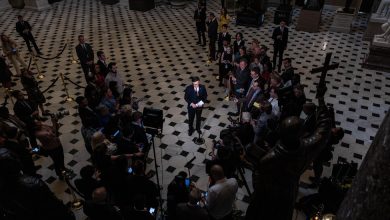Adams, Hailed on the National Stage, Finds Frustration Closer to Home

Mayor Eric Adams was supposed to have an easier time in Albany.
As a former New York State senator, he knew many of the key players at the State Capitol and was familiar with its traditions. He appeared to have a good relationship with Gov. Kathy Hochul. And after a decisive win in New York City’s mayoral race, he was hailed as a national leader in the Democratic Party.
But as the state legislative session ended this week, Mr. Adams did not get many of the things he had asked for.
He had requested a four-year extension of mayoral control for New York City schools, but he received only two — a major disappointment. He had pushed for the renewal of a tax incentive program for New York City real estate developers known as 421a, to help subsidize the construction of affordable housing, but it was allowed to expire.
He was also given two things he did not ask for: Lawmakers required the city to reduce class sizes over the next five years, a move the mayor said the city could not afford; and they also reduced his power over the Panel for Educational Policy, the governing body for the city’s public schools.
“We have good partners in Albany who are fighting hard for us,” Mr. Adams said on Wednesday at a breakfast with civic leaders. “But there are some professional naysayers that I believe — a small number of people, we need to be clear on this, a small number — they’re not on Team New York and getting things done.”
New York City mayors have long had difficulties getting what they want from Albany. In theory, state leaders and the mayor of the nation’s largest city should share mutual interests, yet that has not always been the case in New York, where conflicting political parties and personalities have often caused rifts.
Mr. Adams’s tension with Albany appeared to be the result of real policy differences with left-leaning Democrats, as well as political squabbles with state lawmakers who also complained of the Adams administration’s lack of outreach.
The mayor appeared to have an ally in Ms. Hochul, though it is unclear how closely they worked together behind the scenes, or how much capital the governor invested in advocating Mr. Adams’s agenda.
Ms. Hochul, for example, publicly pushed for four years of mayoral control of schools, and joined Mr. Adams in arguing for toughening bail laws.
But neither the governor nor the mayor got quite what they wanted on bail changes — a somewhat unsatisfactory result that was tinged with an unusually heated exchange that Mr. Adams had with a state lawmaker.
In fulfilling a longstanding rite of passage, the mayor paid a virtual visit to the State Capitol in February on what is known as Tin Cup Day, to lobby state lawmakers who hold great sway over the city’s schools, finances and streets.
Mr. Adams was confronted by Latrice Walker, an Assembly Democrat from Brooklyn and one of the architects of bail reform, about the mayor’s stance that bail reform had allowed more dangerous criminals onto the streets.
“I don’t think you should debate me, you should debate the 11-month-old baby’s mother,” Mr. Adams said, referring to a child who was shot in the face in January.
“No, it’s you who are making this a political issue,” Ms. Walker said. “I lost a brother at the age of 19 years old to gun violence.”
On Friday, Mr. Adams contended that he had achieved “major victories” in Albany and thanked Ms. Hochul and state lawmakers for working with him.
“While there is more work to do to deliver on the priorities New Yorkers are asking for, we are optimistic that there is a way forward on key elements, including ensuring we achieve the shared goal of smaller class sizes without forcing the city into a fiscal crisis and impacting programs for our most vulnerable students,” Mr. Adams said in a statement.
To be sure, Mr. Adams had his share of successes. He won the expansion of the city’s speed cameras program to allow them to be on 24 hours a day, seven days a week; he helped secure improved earned-income tax credits for poor New Yorkers and more funding for affordable child care; and he pushed for a new public trust to help pay for repairs to public housing, converting vacant hotels to homes.
Yet Michael Gianaris, the deputy majority leader of the State Senate, has complained that Mr. Adams did not work closely enough with state lawmakers who represent the city. State lawmakers have also criticized the mayor’s plans to reduce gun violence and his sweeps of homeless encampments.
The Adams administration insisted that it had a strong presence in Albany and “engaged with more than 80 members” of the State Legislature and their staffs. Key officials like Keechant Sewell, the police commissioner, and David C. Banks, the schools chancellor, visited Albany to push their causes.
The mayor has also said that he has a good working relationship with certain Democratic legislators, singling out Senator John Liu and Assemblywoman Jenifer Rajkumar.
“I communicated with many of the lawmakers in the state,” Mr. Adams said in an interview in April. “Those who have shown the alignment to understanding the importance of the issues that I am pushing.”
The speed camera expansion was a key issue for Mr. Adams at a time when the city is seeing a troubling rise in traffic deaths. Cameras were only allowed on from 6 a.m. to 10 p.m. on weekdays — even though nearly 60 percent of fatal crashes in the city took place outside those hours. But Mr. Adams had asked for local control of the speed camera program, and state lawmakers ultimately decided not to hand it over.
Mr. Adams also pressed hard for mayoral control of schools. He repeatedly argued that he and his schools chancellor were Black men who attended the city’s public schools, and it would be wrong to deny them control after approving it for his predecessors, Bill de Blasio and Michael R. Bloomberg, who are white and grew up in the Boston area.
“If mayoral accountability was given to folks that were Red Sox fans, you darn sure can give it to people who are Yankees and Mets fans,” Mr. Adams said at a speech on April 26 to mark his first 100 days in office.
Mr. Bloomberg in 2009 got a six-year extension of control over the city’s schools, while Mr. de Blasio had to settle, at times, for a one-year extension. Mr. Adams and Mr. Banks, the schools chancellor, criticized the two-year deal this week, arguing that it was too short and did not give students stability as the school system recovered from the pandemic.
Diane Savino, a state senator who endorsed Mr. Adams for mayor, said she was disappointed by the schools-control deal, as well as the agreement to weaken the mayor’s power on the Panel for Educational Policy. Ms. Savino said the new rules would make it difficult for Mr. Adams to implement his education agenda and that some lawmakers saw an opportunity to “put their own stamp on the school system.”
“Whether it was because some people wanted to accomplish their long held goals or they had a difference of opinion with the current occupant of City Hall, I can’t answer,” she said. “But I think Albany did New York City a terrible disservice.”
Andrea Stewart-Cousins, the Senate majority leader, seemed surprised by the pushback. She said on Wednesday that she had informed Mr. Adams about their plans and that he appeared to have accepted it.
“Over the past few days, I’ve spoken to him and the speaker and we told him where we were at some point,” she said. “He was OK with it.”
Grace Ashford contributed reporting from Albany, N.Y.




